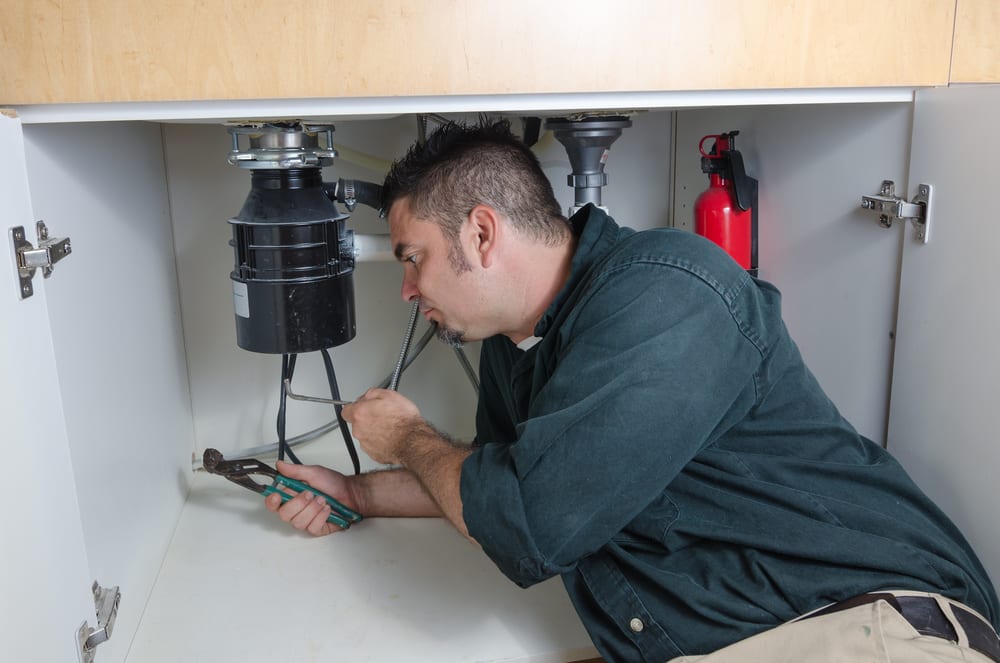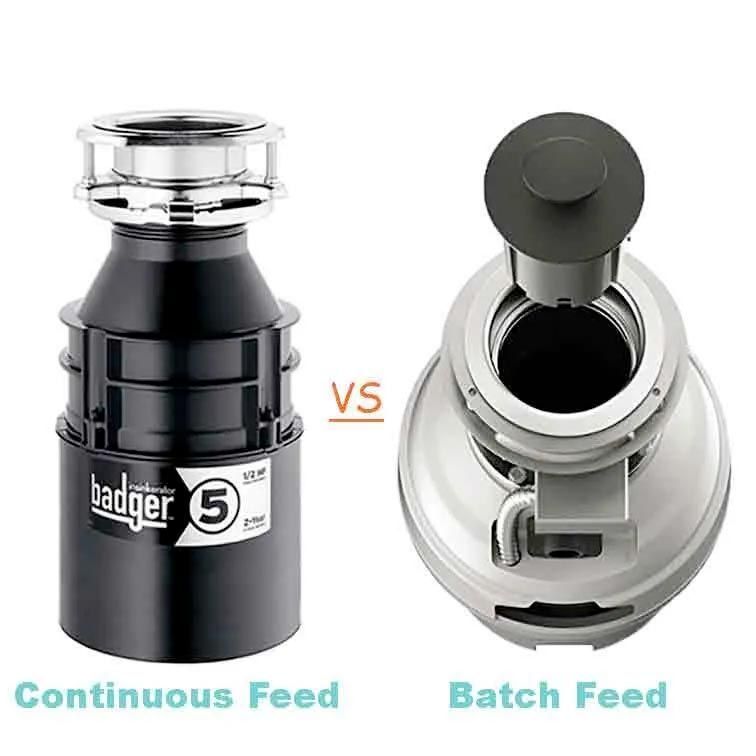Are you on the hunt for a new garbage disposal but feeling stuck between batch feed and continuous feed options? You’re not alone.
Choosing the right garbage disposal can be a daunting task, especially when both types promise to make your kitchen cleanup a breeze. But which one truly suits your lifestyle and kitchen habits? You’ll discover the key differences between batch feed and continuous feed garbage disposals.
We’ll dive into their pros and cons, helping you make an informed decision. Stick around, because by the end of this read, you’ll know exactly which disposal type fits seamlessly into your kitchen routine. Your perfect kitchen companion awaits!

Credit: www.fenwickhomeservices.com
Batch Feed Disposals
Batch feed disposals enhance kitchen safety by operating with a cover, while continuous feed models offer convenience by running without interruption. Both types efficiently manage food waste, but batch feeds are ideal for households prioritizing safety. Continuous feeds suit those who prefer quick, uninterrupted disposal processes.
Batch feed disposals provide a unique way to manage kitchen waste. These disposals are known for their safety and efficiency. Unlike continuous feed disposals, batch feed models require a lid to operate. This simple change makes them a popular choice for families concerned about safety.Operation Method
Batch feed disposals operate using a distinct method. Waste is added in batches, not continuously. This requires placing food scraps in the disposal and securing the lid. Turning the lid activates the grinding process. This method prevents accidental operation and reduces noise.Safety Features
Safety is a major benefit of batch feed disposals. The lid mechanism ensures the disposal only runs when securely closed. This prevents accidental activation and protects users from potential hazards. It’s an ideal choice for homes with children, adding peace of mind.Installation Requirements
Installing a batch feed disposal is straightforward. The unit fits under the sink like continuous feed models. It may require a dedicated electrical outlet. Professional installation ensures proper setup and function. Consider consulting a plumber for optimal installation.Ideal Usage Scenarios
Batch feed disposals suit various kitchen setups. They are perfect for families with safety concerns. Homes with limited sink space benefit from their compact design. Batch feed models are great for occasional use, reducing energy consumption during operation.Continuous Feed Disposals
Continuous feed disposals allow for seamless waste processing while running water. Ideal for frequent use and larger households. In contrast, batch feed disposals operate only when a lid is engaged, offering a safer option for families with children. Both types efficiently manage kitchen waste, catering to different needs.
Continuous feed disposals are popular in modern kitchens. They offer convenience and efficiency. These units grind food waste continuously. This means less time spent managing kitchen waste. Many households prefer them for their ease of use. Let’s explore how they work and their ideal usage scenarios.Operation Method
Continuous feed disposals start with a switch. The unit grinds food while water runs. This process is seamless and fast. It handles large amounts of waste. This makes it efficient for busy kitchens. Users can add waste as the unit operates. This results in less waiting time.Safety Considerations
Continuous feed disposals have some safety concerns. The open design allows hands to enter. Users must be cautious. An accidental hand slip can cause injury. It’s essential to keep children away. Always turn the unit off before reaching inside.Installation Requirements
Installing continuous feed disposals is straightforward. Most units fit standard sink openings. They require a power source nearby. Some models need professional installation. Check the manufacturer’s guidelines. Ensure all connections are secure to avoid leaks.Ideal Usage Scenarios
These disposals suit large families. They are perfect for frequent cooking. They handle large volumes of waste easily. Busy households benefit from their efficiency. They keep kitchens clean with minimal effort. Ideal for those who want quick waste disposal.Performance And Efficiency
When considering garbage disposals, understanding their performance and efficiency is crucial. You want a system that effectively grinds waste, operates quietly, and doesn’t hike up your energy bills. Let’s dive into how batch feed and continuous feed models stack up against each other in these key areas.
Grinding Power
Grinding power determines how well your disposal handles food waste. Batch feed disposals often have robust motors, ensuring they pulverize waste efficiently. You might find them perfect for dealing with tougher scraps, like bones or fibrous vegetables. Continuous feed models, however, offer the advantage of disposing of waste as you go. This can be particularly useful during meal prep or cleanup. Which sounds more suited to your cooking style?
Noise Levels
Noise can be a deciding factor for many homeowners. Batch feed disposals generally operate quieter since they require a cover to activate. This design can help dampen the sound, allowing for a more peaceful kitchen environment. Continuous feed disposals, while convenient, often run louder due to their open operation. Imagine hosting a dinner party—would you prefer the low hum of a batch feed or the louder churn of a continuous model?
Energy Consumption
Energy efficiency is essential for reducing your carbon footprint and utility bills. Batch feed disposals typically consume less energy as they’re used intermittently. You control when the disposal runs, which can prevent unnecessary power usage. Continuous feed models, while efficient in handling large volumes, can use more electricity due to prolonged operation. Think about your usage patterns—do you tend to dispose of waste in one go or gradually throughout the day?
Choosing between batch feed and continuous feed garbage disposals boils down to your personal preferences and kitchen habits. As you weigh the pros and cons, consider your priorities in grinding power, noise levels, and energy consumption. How do these factors align with your lifestyle?

Credit: shouldit.com
Cost Analysis
When choosing between batch feed and continuous feed garbage disposals, understanding the cost implications is crucial. This analysis breaks down the expenses involved, from the initial purchase to ongoing maintenance. Let’s dive into the financial aspects you should consider before making a decision.
Initial Purchase Cost
Continuous feed disposals are generally cheaper upfront compared to batch feed models. The latter often include additional safety features, which can drive up the price. It’s like buying a smartphone—do you want the basic model or the one with all the bells and whistles?
Ask yourself: is your budget flexible for a higher initial cost if it means enhanced safety for your family?
Installation Costs
Installing a garbage disposal can vary in complexity. Continuous feed systems tend to be easier and cheaper to install. Batch feed models might require specialized fitting, leading to higher installation costs.
Consider whether you’re comfortable with DIY installation or prefer hiring a professional. Sometimes saving a few bucks on installation means spending more time scratching your head.
Maintenance Expenses
Maintenance is where continuous feed disposals often shine. They have fewer moving parts, which can mean lower maintenance costs over time. Batch feed disposals might require more frequent attention due to their complex mechanisms.
Think about how much time and money you’re willing to invest in upkeep. Would you prefer a system that requires less attention, or are you okay with occasional maintenance for added safety?
Ultimately, your choice will depend on balancing initial costs, installation ease, and ongoing maintenance. Take a moment to weigh these factors against your priorities—safety, budget, and convenience. What matters most to you?
Environmental Impact
Choosing between batch feed and continuous feed garbage disposals affects environmental impact. Batch feed models minimize waste risk, enhancing safety and conserving energy. Continuous feed disposals offer convenience and speed but may consume more electricity, potentially increasing environmental footprints.
When choosing a garbage disposal system, it’s crucial to consider the environmental impact. Batch feed and continuous feed disposals each have unique effects on the environment. Understanding these can guide you in making a more eco-friendly choice for your home.Waste Management
Batch feed disposals often result in less waste going down the drain. Because they require you to load the chamber before operation, you’re more likely to think about what you’re disposing of. This can lead to better waste separation and more composting. Continuous feed disposals might encourage mindless disposal. The convenience of running the disposal while adding scraps means you might send more waste into the sewer system. This could potentially increase your household’s environmental footprint.Energy Usage
Batch feed disposals generally use less energy. They operate only when fully loaded, which can mean fewer runs and less energy consumed. This can be a small but meaningful way to reduce your home’s energy consumption. Continuous feed disposals might use more energy, as they can run longer when food waste is added gradually. This continuous operation could lead to higher electricity usage, impacting your utility bills and the environment.Eco-friendly Options
Some garbage disposals are designed with eco-friendliness in mind. Look for models that emphasize energy efficiency and waste reduction. Some even have features that help grind food waste into smaller particles, easing the burden on sewer systems. Consider whether you really need a garbage disposal at all. Would composting be a better option for you? This natural process turns food waste into nutrient-rich soil, reducing your environmental impact significantly. Think about how your choice of garbage disposal affects your home’s overall sustainability. Are you making the most environmentally conscious decision? Your choice can have a lasting impact on the planet.
Credit: www.fenwickhomeservices.com
Choosing The Right Disposal
Finding the right garbage disposal is crucial for your kitchen’s efficiency. Understanding the differences between batch feed and continuous feed helps make an informed choice. Each type offers unique benefits suited to different needs.
Household Needs
Consider the size of your household. Larger families may prefer continuous feed disposals. They handle a larger volume of waste without stopping. Batch feed disposals suit smaller households. They offer more safety, as they only work with the lid in place. Think about your cooking habits too. Frequent cooks may benefit from a continuous feed’s convenience.
Budget Considerations
Budget plays a vital role in your decision. Continuous feed disposals are often more affordable. They are widely available and easy to install. Batch feed models are usually higher in cost. They offer added safety features, which can be a good investment. Consider installation costs as well. Some disposals may require professional help, adding to the expense.
Long-term Benefits
Think about the long-term benefits of each type. Continuous feed disposals can save time. They allow for quick waste disposal during busy cooking sessions. Batch feed disposals offer safety and control. They prevent accidents with their locking mechanism. Both types can be durable with proper maintenance. Ensure you choose a reliable brand for longevity.
Frequently Asked Questions
What Is The Main Difference Between Batch And Continuous Feed Garbage Disposals?
Batch feed disposals require a cover to operate. Continuous feed disposals run continuously when switched on.
Are Batch Feed Disposals Safer Than Continuous Feed?
Yes, batch feed disposals are safer. They only operate when the cover is in place, reducing accidents.
Which Disposal Type Is More Convenient For Large Families?
Continuous feed disposals are more convenient. They handle large waste amounts without needing to stop and start.
Do Batch Feed Disposals Cost More Than Continuous Feed Ones?
Yes, batch feed disposals often cost more. Their safety features and design make them pricier.
Can Continuous Feed Disposals Be Noisier Than Batch Feed?
Yes, continuous feed disposals can be noisier. They operate without a cover, making them louder.
Conclusion
Choosing the right garbage disposal is important. Batch feed offers safety and control. Continuous feed provides convenience and speed. Each type has its own benefits. Consider your kitchen needs. Think about your family’s habits. Safety might be a priority for some.
Others might value speed and ease. Both options serve well in different situations. Make a choice that fits your lifestyle best. Garbage disposals are essential kitchen tools. They make waste management easy. Find the one that suits you. Enjoy a cleaner kitchen experience.




